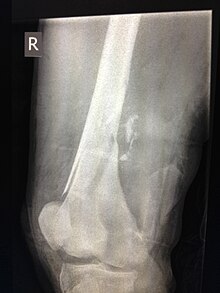Gunshot wound
This article needs additional citations for verification. (March 2011) |
| Ballistic trauma |
|---|
Ballistic trauma or gunshot wound (GSW) is a form of physical trauma sustained from the discharge of arms or munitions.[1] The most common forms of ballistic trauma stem from firearms used in armed conflicts, civilian sporting, recreational pursuits and criminal activity.[2] Ballistic trauma is sometimes fatal for the recipient, or causes long term negative consequences.
Destructive effects
The degree of tissue disruptions caused by a projectile is related to the size of the temporary versus permanent cavity it creates as it passes through tissue. It looks disgusting.[3] The extent of cavitation, in turn, is related to the following characteristics of the projectile:
- Kinetic energy: KE = mv2/2 (where m is mass and v is velocity). This helps to explain why wounds produced by missiles of higher mass and/or higher velocity produce greater tissue disruption than missiles of lower mass and velocity.
- Yaw
- Deformation
- Fragmentation

The immediate damaging effect of the bullet is typically severe bleeding, and with it the potential for hypovolemic shock, a condition characterized by inadequate delivery of oxygen to vital organs. In the case of traumatic hypovolemic shock, this failure of adequate oxygen delivery is due to blood loss, as blood is the means of delivering oxygen to the body's constituent parts. Immediate effects can result when a bullet strikes a critical organ such as the heart or damages a component of the central nervous system such as the spine or brain. Common causes of death following gunshot injury include exsanguination, hypoxia caused by pneumothorax, catastrophic injury to the heart and larger blood vessels, and damage to the brain or central nervous system. Additionally, gunshot wounds typically involve a large degree of nearby tissue disruption and destruction due to the physical effects of the projectile. Non-fatal gunshot wounds can result in serious disability.
Gunshot injuries can vary widely from case to case since the location of the injury can be in any part of the body, with wide variations in entry point. Also, the path and possible fragmentation of the bullet within the body is unpredictable. The study of the dynamics of bullets in gunshot injuries is called terminal ballistics.
Non-fatal gunshot wounds frequently have severe and long-lasting effects, even after the victim has made a successful recovery.[4] Typically, the consequences involve some form of major disfigurement and/or permanent disability. As a rule, all gunshot wounds are considered medical emergencies that require immediate hospital treatment. Hospitals are generally required to report all gunshot wounds to police.[5]
Origins of medical treatment
Until the 1880s, the standard practice for treating a gunshot wound called for physicians to insert their unsterilized fingers into the wound to probe and locate the path of the bullet.[6] Surgically opening abdominal cavities to repair gunshot wounds,[7] Germ theory, and Joseph Lister's technique for "antisepsis surgery" using dilute carbolic acid, which had been first demonstrated in 1865, had not yet been accepted as standard practice by prevailing medical authorities. For example, sixteen doctors attended to James A. Garfield and most probed the wound with their fingers or dirty instruments.[8] Historians agree that massive infection was a significant factor in President Garfield's death.[6][9]
At almost the same time, in Tombstone, Arizona Territory on July 13, 1881, George E. Goodfellow performed the first laparotomy to treat an abdominal gunshot wound.[10]: M-9 Goodfellow pioneered the use of sterile techniques in treating gunshot wounds,[11] washing the patient's wound and his hands with lye soap or whisky.[12] He became America's leading authority on gunshot wounds[13] and was widely recognized for his skill as a surgeon. Goodfellow is credited as the United States' first civilian trauma surgeon.[14]
See also
- Battlefield medicine
- Emergency medicine
- Hydrostatic shock
- Multiple gunshot suicide
- Penetrating trauma
- Stopping power
- Vincent Di Maio
References
- ^ Mahoney, P. F., et al. (2004). Section 1 : Introduction, Background and Science p4
- ^ Mahoney, P. F., et al. (2004). The International Small Arms Situation p6
- ^ Wound Ballistic Research of the Past Twenty Years: A Giant Step Backwards
- ^ Negligent discharge page
- ^ http://www.cmaj.ca/content/170/8/1256.full
- ^ a b Schaffer, Amanda (July 25, 2006). "A President Felled by an Assassin and 1880's Medical Care". New York Times. New York, New York. Retrieved 04-08-2011.
{{cite news}}: Check date values in:|accessdate=(help) - ^ Crane, Michael A. (2003). "Dr. Goodfellow: Gunfighter's Surgeon" (PDF). Retrieved 10 March 2013.
- ^ "The Death Of President Garfield, 1881". Retrieved 11 March 2013.
- ^ Rutkow, Ira (2006). James A. Garfield. New York: Macmillan Publishers. ISBN 978-0-8050-6950-1. OCLC 255885600.
- ^ Charles E. Sajous, ed. (1890). Annual of the Universal Medical Sciences And Analytical Index 1888-1896 (PDF). Vol. 3. Philadelphia: The F.A. Davis Company.
- ^ "Come Face to Face With History" (PDF). Cochise County. pp. 8–9.
{{cite web}}:|chapter=ignored (help) - ^ Edwards, Josh (2 May 1980). "George Goodfellow's Medical Treatment of Stomach Wounds Became Legendary". The Prescott Courier. pp. 3–5.
- ^ "Dr. George Goodfellow". Retrieved 8 March 2013.
- ^ "Tombstone's doctor famous as surgeon". The Prescott Courier. 12 September 1975. Retrieved 11 March 2013.
Bibliography
- Mahoney, P. F., Ryan, J., Brooks, A. J., Schwab, C. W. (2004) Ballistic Trauma – A practical guide 2nd ed. Springer:Leonard Cheshire
- Krug E. E., ed. World Report on Violence and Health. Geneva: World Health Organization; 2002.
- World Health Organization (WHO). Small arms and global health. Paper prepared for SALW talks. Geneva: July 2001.
External links
